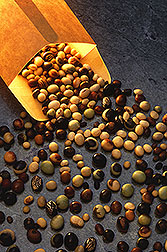This page has been archived and is being provided for reference purposes only. The page is no longer being updated, and therefore, links on the page may be invalid.
Read the magazine story to find out more. |
|
Biodiesel Production Gets Simplified with New Method
By Jim CoreApril 12, 2005
An Agricultural Research Service (ARS) scientist may have found a way to remove a costly component of biodiesel production.
Michael Haas, a biochemist with the ARS Eastern Regional Research Center's Fats, Oils and Animal Coproducts Research Unit in Wyndmoor, Pa., has developed a new approach to synthesizing biodiesel.
Soybean oil is the prevalent starting material in the United States for biodiesel, and its relatively high cost results in a high cost for this renewable fuel.
The method developed by Haas and his colleagues eliminates the use of hexane, an air pollutant regulated by the U.S. Environmental Protection Agency, from the production of soy oil for biodiesel synthesis. Hexane, a colorless, flammable liquid derived from petroleum, is traditionally used to extract vegetable oil triglycerides from the raw agricultural material before biodiesel production.
The new method eliminates the conventional oil extraction step. Instead, the oilseed is incubated with methanol and sodium hydroxide, which are currently used to process extracted oil.
The researchers found that the moisture naturally present in soybeans--as much as 10 percent in soy flakes--requires that a large amount of methanol be used in this reaction. However, using dried flakes greatly reduced the methanol requirement. Processing costs using dry flakes were estimated at $1.02 per gallon, which is $2.12 less than for biodiesel made from full-moisture soy flakes.
The researchers are refining their economic model to account for income from the sale of the lipid-free, protein-rich flakes left over from the biodiesel reaction for use as animal feeds, and to account for differences in the cost of the refined oil and flaked soybean feedstocks.
ARS has filed a patent application on the process, which might be useful in producing biodiesel from lipids remaining in the corn meal byproduct of corn-to-ethanol plants.
Read more about the research in the April issue of Agricultural Research magazine.
ARS is the U.S. Department of Agriculture's chief scientific research agency.

